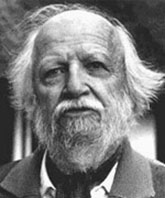Alfred Bester
Critique • Works • Views and quotes

Born
New York City, US, 1913
Died
Doylestown, Pennsylvania, 1987
Publications
Novels, stories, plays, poetry, screenplays
Genres
Novels, stories, scripts, comics, travel writing
Writing language
English
Place of writing
United States
Literature
• The Stars My Destination (1956)
Novels
• The Demolished Man (1953)
• The Stars My Destination (1956)
American Literature
• The Stars My Destination (1956)
Science Fiction
• The Demolished Man (1953)
• The Stars My Destination (1956)
Science Fiction Stories
• "Fondly Fahrenheit" (1954)
Odd man out in a strange field
Other giants of science fiction who emerged during the genre's Golden Age were notoriously prolific. Isaac Asimov counted over five hundred books in his output, plus hundreds of stories and articles. Arthur C. Clarke, Ray Bradbury, Theodore Sturgeon and Robert Heinlein produced novels, stories and collections annually throughout their writing lives.
But Alfred Bester's reputation rests on only a handful of scifi novels—on two really—and some highly regarded but not widely known stories.
Yet, his small production is considered seminal for modern SF. The Science Fiction and Fantasy Writers of America consider him a Grand Master in the field.
But maybe this is not a paradox. Perhaps it is precisely Bester's lack of dedication to the genre that made him one of its great innovators. Perhaps, because he was not continuously steeped in its traditions and practices, when he turned his attention to science fiction he wrote it as no one else had. He was able to create prose that showed the way forward from classic science fiction to the new wave of speculative fiction, which younger writers took up and are still following.
It is fortunate for us then that Alfred Bester never had the drive to produce the mountains of work his contemporaries did. Not that he didn't have the skill or talent to do so, but rather he had other interests.
Unseen writer
New York-born and bred, Bester dropped out of law school in his twenties and became a commercial writer, mainly in public relations. He started writing science fiction on the side, publishing in the pulp magazines such stories as his first in 1939, "Broken Axiom", and the still admired "Adam and No Eve" in 1941.
But he dropped this sideline as his main career moved into scripting comic books, radio shows and early television programs. He was an unseen writer behind such such popular culture figures as Captain Marvel, Mandrake the Magician, The Shadow, Superman, Batman, Green Lantern and Tom Corbett: Space Cadet.
In the 1950s, Bester returned to prose with more stories, including two of his most famous, "Fondly Fahrenheit" and "Star Light, Star Bright", both of which he also adapted for television. The breadth of style and level of experimentation—the sheer cleverness—in the short stories he wrote in this period is staggering for science fiction.
Most notable writers in the field find a certain voice that works for them and then use it over and over again. But for Bester, every story tried something different. Some efforts worked better than others, some worked brilliantly, and a few didn't work at all, perhaps seeming on first reading as too clever by half. But read them in collections like Starburst (1958) and The Dark Side of the Earth (1964), and you'll find them all full of intriguing fictional ideas. Even the story titles are bizarre and wonderful: "Oddy and Id", "The Men Who Murdered Mohammed", "The Pi Man", "The Flowered Thundermug", "They Don't Make Life Like They Used To", "5,271,009", "Ms. Found In a Champagne Bottle"—the best this side of Philip K. Dick.
More importantly for his reputation though, a longer work, The Demolished Man, was serialized in Galaxy magazine and published in book form in 1953. Bester's first novel was like no science fiction novel before it, a fast-paced story in the future pitting a murderous corporate baron against a mind-reading cop with both sides employing help from ESP-gifted individuals. The game of reading, blocking and tricking each other is played out at times with unconventional grammar and typography to represent thoughts. The Demolished Man became the first winner of science fiction's top award, the Hugo, for best novel of the year and is still considered a scifi classic.
A non-science fiction novel Who He? (also known as The Rat Race), about a game show host who loses his memory, appeared the same year but remains little known. However, its movie rights were sold, making the author and his wife enough money to travel abroad for several years.
While living in Europe and England, he wrote and published the SF novel The Stars My Destination (released in 1957 as Tiger! Tiger! in Britain)—again first as a serial and then as a book. The novel has proved as enduring as The Demolished Man, repeatedly being hailed as one of the greatest science fiction novels of all time, if not the greatest.
And so, having scaled this height with his work, Alfred Bester of course put it aside. He didn't write another novel of any kind for another eighteen years. He instead worked for a travel magazine as a travel writer and literary editor.
He wandered back to science fiction in the 1970s with short stories and novels The Computer Connection (1975, also published as Extro), Golem100 (1980) and The Deceivers (1981), which are regarded less highly regarded than his 1950s breakthroughs.
At the end of his life, the Science Fiction and Fantasy Writers of America conferred its Grand Master Nebula Award on him. Since his death in 1987, Bester's reputation as a giant of the field has continued to grow with continued references in popular culture to him and his work, especially his two best-known science fiction novels.
Not bad for a comic scripter and travel writer.
— Eric
Critique • Works • Views and quotes

